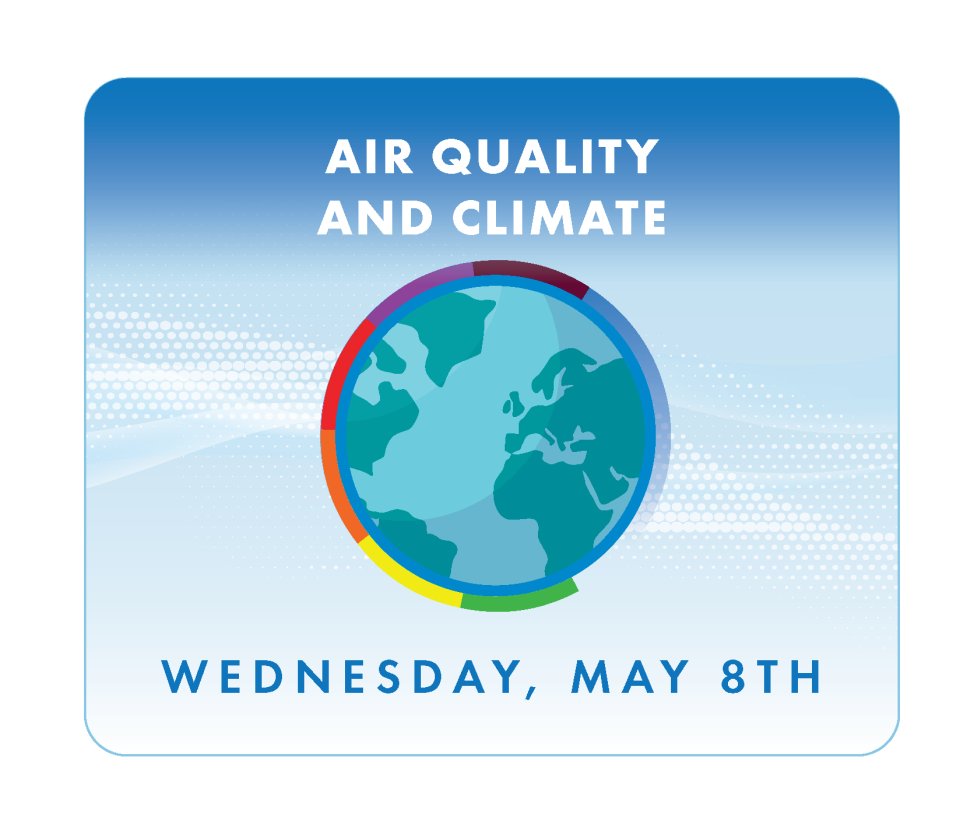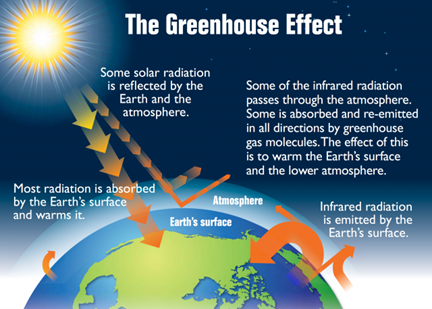Air Quality and Climate

Clean air is important to everyone, every day. Air Quality Awareness Week highlights the work that EPA and our partners are doing to understand how climate change is impacting air quality and address the connected challenges of climate change and air pollution. Reducing greenhouse gas emissions is vital for addressing climate change and protecting air quality.
On this page:
Air Quality and Climate Change Basics

The Earth's climate is changing due to a buildup of greenhouse gases in our atmosphere that is amplifying the greenhouse effect. Multiple lines of evidence show changes in our weather, oceans, and ecosystems, such as: changing temperature and precipitation patterns, increases in ocean temperatures, sea level, and acidity, the melting of glaciers and sea ice, and changes in the frequency, intensity, and duration of extreme weather events.
Climate change harms air quality in many ways. In many areas of the United States, climate change is expected to worsen harmful ground-level ozone, increase people's exposure to allergens like pollen, and degrade air quality, which can all negatively impact human health. Many people are disproportionately impacted by air pollution, including those who live in communities of color and low-income communities. Climate change can amplify the inequitable experiences of poor air quality in these communities.
What is the greenhouse gas effect?
When sunlight reaches the earth's surface, it can either be reflected back into space or absorbed by the Earth. Incoming energy that is absorbed by the Earth warms the planet. Once absorbed, the planet releases some of the energy back into the atmosphere as heat. Solar energy that is reflected back to space does not warm the Earth. Certain gases in the atmosphere absorb energy, slowing or preventing the loss of heat to space. Those gases are known as "greenhouse gases". They act like a blanket, making the Earth warmer than it would otherwise be. The greenhouse effect helps trap heat from the sun, which keeps the temperature on Earth comfortable. But people's activities are increasing the amount of heat-trapping greenhouse gases in the atmosphere, causing the Earth to warm up.
Watch EPA's Greenhouse Gas Effect video to learn more!

Test Your Knowledge
A. The correct answer is True

D is the correct answer.

C is the correct answer.

Explanation: CASTNET has 99 sites located throughout the U.S. and Canada. These sites are managed by @EPAairmarket, @NatureNPS, @BLMWyoming, and other federal, state, and local partners including seven Native American Tribes. Learn more by visiting EPA's CASTNET website for more information.
Hey... No Peeking!
You need to select an answer to the question before we'll show you the right answer...
What is causing climate change?
Since the Industrial Revolution, human activities have released large amounts of carbon dioxide and other greenhouse gases into the atmosphere, which has changed the Earth's climate. The largest source of greenhouse gas emissions from human activities in the United States is from burning fossil fuels for electricity, heat, and transportation. Natural processes, such as changes in the sun's energy and volcanic eruptions, also affect the Earth's climate. However, they do not explain the warming that we have observed over the last century. Human activities are responsible for almost all of the increase in greenhouse gases in the atmosphere over the last 150 years. Learn more about the causes of climate change.
What are the top climate impacts on air quality at both local and regional scales?
- Outdoor and indoor air pollution. Climate-driven changes in weather conditions, including temperature and precipitation, are expected to increase ground-level ozone and particulate matter. These changes worsen existing air pollution and exposure to these pollutants leads to or worsens health problems, such as respiratory and heart diseases. Increases in outside air pollutants, such as ground-level ozone and particulate matter, could lead to higher indoor exposures. These pollutants can enter a building in many ways, including through open doors, windows, and ventilation systems. Indoor air pollutants have been linked to heart disease and respiratory diseases, such as asthma.
- Indoor air pollution. Increases in outdoor air pollutants, such as ground-level ozone and particulate matter, could lead to higher indoor exposures. These pollutants can enter a building in many ways, including through open doors, windows, and ventilation systems and mix with pollutants emitted or generated from within a structure elevating pollutant levels indoors. Indoor and outdoor air pollutants have been linked to heart disease and respiratory diseases, such as asthma.
- Wildfire smoke. Climate change has led to more frequent wildfires and a longer wildfire season. Wildfire smoke pollutes the air and can spread hundreds of miles downwind to other regions. Exposure to wildfire smoke can worsen respiratory illnesses, such as asthma, chronic obstructive pulmonary disease (COPD), and bronchitis.
- Airborne allergens. Climate change is expected to cause earlier and longer springs and summers, warmer temperatures, precipitation changes, and higher carbon dioxide concentrations. These changes can increase people's exposure to pollen and other airborne allergens, leading to more allergy-related illnesses, such as asthma.
For more specific examples of climate change impacts in your region, please see the National Climate Assessment. Explore the Air Quality chapter to learn more about climate and air quality connections.
What can we do to reduce climate and air quality impacts?
There are opportunities at individual, local, regional, and national scales that can help reduce climate and air quality impacts. Learn more about what EPA is doing to address current and future air pollution challenges. Reducing greenhouse gas emissions is key to addressing climate change, while also protecting air quality.
Learn what you can do to lessen the impacts of climate change by making choices that help advance solutions and reduce greenhouse gas emissions. Not only are these actions good for the environment, but they are also good for personal and community health, equity, environmental justice, quality of life, and our shared values.
Communities can take action:
- Go green. Switch to green power from renewable energy sources like solar, wind, and hydropower to reduce both air pollution and greenhouse gas emission.
- Improve air quality at ports. Communities situated near ports - which often include minority communities - are at a higher risk of air pollution exposure. Communities and stakeholders can work with EPA's Ports Initiative to improve environmental performance and advance clean technologies at ports. This effort helps people living near ports breathe cleaner air. Check out the Community-Port Collaboration Toolkit for ways communities can get involved.
- Plant trees. Planting trees, especially in urban areas along roads or highways, can help improve air quality. Trees also provide other benefits, such as reducing the impact of urban heat islands.
- Stay informed about the Clean School Bus Program. With funding from the Bipartisan Infrastructure Law, EPA's Clean School Bus Program provides $5 billion over the next five years (FY 2022-2026) to replace existing school buses with zero-emission and low-emission models. Visit the webpage to sign up to receive the latest information about upcoming funding opportunities, how to apply, the eligible technologies and their benefits, and best practices and lessons learned.
Individuals can take action:
- Reduce your exposure. Use the Air Quality Index to guide outdoor activities. When you see that the AQI is unhealthy, take simple steps to reduce your exposure like choosing less intense activities, taking more breaks, and rescheduling activities to a time when outdoor air quality is better.
- Reduce air pollution from vehicles. Walking, biking, and taking public transit, among other actions, can reduce emissions from transportation. These choices can also provide other benefits, such as safer streets.
- Reduce your Carbon Footprint. Many of our daily activities - such as using electricity, driving a car, or disposing of waste - cause greenhouse gas emissions. Together, these emissions make up a household's carbon footprint. Try EPA's Household Carbon Footprint Calculator to estimate your annual greenhouse gas emissions.
- Improve indoor air quality. Reduce or remove sources of indoor air pollutants whenever possible. For example, consider using portable air purifiers or high-efficiency filters in your heating, ventilation, and air conditioning systems.
- Help prevent wildfires. Pay attention to weather and drought conditions. Avoid activities involving fire or sparks when it's dry, hot, and windy to help prevent wildfires.
Visit EPA's Climate Change Impacts on Air Quality website to learn more about how climate change effects air quality and what actions you can take to help mitigate climate's impact on our air.
Test Your Knowledge
A. The correct answer is True

D is the correct answer.

C is the correct answer.

Explanation: CASTNET has 99 sites located throughout the U.S. and Canada. These sites are managed by @EPAairmarket, @NatureNPS, @BLMWyoming, and other federal, state, and local partners including seven Native American Tribes. Learn more by visiting EPA's CASTNET website for more information.
Hey... No Peeking!
You need to select an answer to the question before we'll show you the right answer...
Climate Tools and Your Community
Multiple interactive EPA screening and mapping tools are available online. These tools provide information on local air quality, pollutant levels, pollutant sources, and health risks. Explore our mapping tools to learn about your area today!
Where can I learn about facility level air emissions?
FLIGHT, or the Facility-Level Information on Greenhouse gases Tool, provides information about greenhouse gas emissions from large facilities in the U.S. These facilities are required to report annual data about greenhouse gas emissions to EPA as part of the Greenhouse Gas Reporting Program. Take a tour of what you can find in FLIGHT to get started.
Where can I learn more about environmental justice related indicators?
Get to know your community by learning what climate-related issues affect your neighborhoods, who is most vulnerable, and how you can help. Use EPA's environmental justice screening tool, EJScreen, to identify areas that may have higher environmental burdens and vulnerable populations. EJScreen users choose a geographic area; the tool then provides demographic socioeconomic and environmental information for that area.
Visit the EJScreen website to learn about the tools features and to access guidance on how to use the tool.
Where can I learn more about power plants and neighboring communities?
The Power Plants and Neighboring Communities Mapping Tool identifies the locations of power plants and highlights the key demographics of people living within three miles of those plants. The map displays all fossil fuel-fired power plants that supply electricity to the grid.
Burning fossil fuels at power plants creates emissions of sulfur dioxide (SO2), nitrogen oxides (NOx), particulate matter (PM), carbon dioxide (CO2), mercury (Hg), and other pollutants. NOx and SO2 emissions contribute to the formation of ground-level ozone and find PM, which can lead to respiratory and cardiovascular problems, and exposure to mercury can increase the possibility of health issues ranging from cancer to immune system damage.
Despite significant reductions in these pollutants from the power sector over the past two decades, important health and environmental concerns persist, especially for minority, low-income, and indigenous populations, who frequently bear a disproportionate burden of environmental harms and adverse health outcomes.
Learn more about this tool's capabilities by visiting the Power Plants and Neighboring Communities website. Join the mailing list for updates.
EPA's Climate Work
Understanding and addressing climate change is critical to EPA's mission of protecting human health and the environment. EPA tracks and reports greenhouse gas emissions and works to reduce emissions to combat climate change and improve air quality. EPA is also committed to advancing the goals of environmental justice for all Americans, including those historically marginalized, overburdened, and living with the legacy of structural racism. Below you will find examples of some of EPA's climate work.
Learn more about what EPA is doing to tackle climate change.
What are EPA's climate change indicators?
EPA has developed more than 50 climate change indicators that show climate-related changes over time and include more than 100 figures as graphs and maps. EPA partners with dozens of data contributors to compile and keep these indicators up to date. Some indicators pertain particularly to air quality, including the ragweed pollen season and drought indicators.
Explore the impacts of climate change through narratives that tell a climate change story with text, figures, maps, and photographs.
What is EPA's Climate Adaption Action Plan?
EPA's 2021 Climate Adaptation Action Plan (pdf) (2.3MB) accelerates and focuses attention on five priority actions the Agency will take to increase human and ecosystem resilience as the climate changes. Check out the EPA Climate Adaptation Website today.
Key offices within EPA, including Regional Offices, have each developed a Climate Adaptation Implementation Plan. These plans describe how each program and region will integrate climate adaptation into its programs, policies, and operation to enable EPA to achieve its mission, even under changing climate conditions. Learn more about EPA's Office of Air and Radiation's Climate Change Adaptation Implementation Plan (pdf) (1MB).
What can people do to maintain healthy indoor air quality as we adapt to climate change?
EPA's Take Action for Climate Readiness and Indoor Air Quality website highlights several steps you can take, such as sealing or insulating your home, to help maintain a healthy indoor air environment as we adapt to the challenges of climate change.
Climate change may worsen existing indoor environmental problems and indoor air quality, and it may also introduce new problems as the frequency or severity of adverse outdoor conditions change. Our homes and buildings, where we spend most of our time, provide protection between us and the outdoors. The design, construction, operation and maintenance of buildings can impact the air we breathe, our energy consumption, and our health. To protect all building occupants and maintain safe and healthy indoor environments, considerations for buildings should include occupant health and well-being, sustainability, energy efficiency, and changing outdoor conditions.
There are three broad approaches to moderate indoor air pollution: source control, ventilation, and air cleaning. Learn more and explore our resources by visiting EPA's webpage Adapting Buildings for Indoor Air in a Changing Climate.
Learning about how to prepare for, respond to, and safely recover from climate- and weather-driven emergencies that affect indoor environments can help protect building occupants and preserve healthy indoor air. EPA shares guidance and information for promoting healthier indoor air before, during, and following emergencies, such as wildfires, severe weather, floods, and power outages. Learn more and explore available resources by visiting EPA's webpage, Emergencies and Indoor Air Quality.
What does EPA recommend we do to protect children and schools from the impacts of climate change?
Children are uniquely vulnerable to climate change in part because they are still growing and developing. They have less control over their environment, less knowledge about health effects from climate change, and are less able to remove themselves from harm. Climate impacts can have lifelong consequences stemming from effects on learning ability, physical development, chronic disease, or other complications.
Parents, caregivers, and clinicians can learn about the effects of climate change on children's health and how best to protect them by reading the Climate Change and Children's Health Report: Summaries.
Schools can start building their climate change resiliency by following the recommendations outlined in the Schools as Cleaner Air and Cooling Centers Factsheets.
What research is EPA doing on climate change?
EPA research improves knowledge of the impacts of climate change on human health and the environment. The scientific information and tools can be used by communities to effectively, equitably and sustainably tackle the climate crisis. Climate Change Research is focused in the following areas:
- Intervention — Research is developing ways that communities and individuals can take action to address the immediate climate threats created by wildfires, floods, droughts and other extreme events, with a focus on the most vulnerable and underserved populations.
- Prevention — Research is providing evidence-based information and resources for all communities to better prepare and respond to the impacts of climate change with long-term approaches to protect public health.
- Transformation — Research is identifying and quantifying the public health and environmental benefits of reducing greenhouse gas emissions and providing tools and resources to develop a more sustainable energy system, while ensuring that the benefits are distributed equitably and improve the lives of all Americans.
A. The correct answer is True

D is the correct answer.

C is the correct answer.

Explanation: CASTNET has 99 sites located throughout the U.S. and Canada. These sites are managed by @EPAairmarket, @NatureNPS, @BLMWyoming, and other federal, state, and local partners including seven Native American Tribes. Learn more by visiting EPA's CASTNET website for more information.
Hey... No Peeking!
You need to select an answer to the question before we'll show you the right answer...

